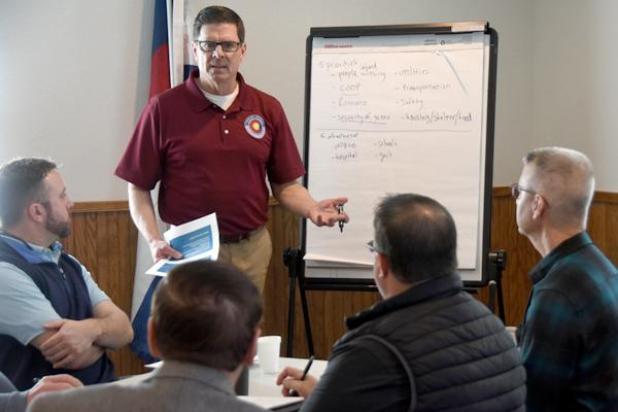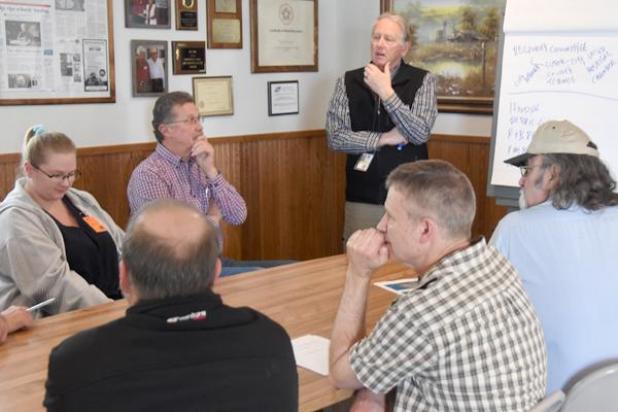
Facilitator John Walker of the Colorado Division of Homeland Security and Emergency Management encourages employees of Phillips County to determine what their top five recovery priorities would be following tornado touchdown in Holyoke. — The Holyoke Enterprise | Johnson Publications

Speaking with representatives from the private sector as well as a few County employees, facilitator Warren Jones discusses what recovery efforts may look like three weeks after a tornado hits Holyoke. — The Holyoke Enterprise | Johnson Publications
Preparedness, community involvement are key when it comes to disaster recovery
“Whole community” is an important concept within the Federal Emergency Management Agency, and on Feb. 22, Phillips County did an impressive job of showing that the whole community is, in fact, committed to preparing for an emergency.
Roughly 50 people gathered at Paoli Town Hall to participate in a recovery workshop led by John Walker of the Colorado Division of Homeland Security and Emergency Management. He and other emergency management professionals facilitated tabletop exercises focused on the recovery phase of an emergency.
Phillips County Office of Emergency Management coordinated the exercise, but many local agencies participated, including hospitals, police departments, EMS, schools, volunteer fire departments and, from the private sector, such businesses as banks and grocery stores.
Many employed by Phillips County itself were also in attendance, representing offices of the clerk, assessor and administrator as well as the landfill, the road and bridge department, and the communications center.
In the case of an emergency, it takes the whole community to recover, and likewise, it’s helpful to have the whole community involved in conversations about what that recovery may look like before the emergency ever happens.
In order to discuss probable responses to an emergency, participants were given a hypothetical scenario: a tornado hitting Holyoke. Facilitators then challenged them to answer questions about response and recovery, keeping in mind the actual resources available. Participants were divided into four groups: first responders, County personnel, private businesses, and municipal and school employees. Each group had its own unique lens through which it viewed the emergency and recovery.
Throughout the workshop, they shared their responses with the entire group, offering perspective and insight that others may not have thought of. Walker emphasized that the participation of private businesses is an asset not often found in these types of training.
Based on real-life events such as the 2008 Windsor tornado, the 2011 Joplin tornado and the 2013 Evans flood, facilitators were able to answer questions about what might happen during recovery.
At the end of the four-hour exercise, Phillips County Commissioner Harlan Stern said, “This was a tremendous exercise today and an eye-opener to the community.” Of course he hopes to never have to put it to practice, but he added that he would rather be overprepared than underprepared.
Phillips County Emergency Manager Bob Heldenbrand was impressed by the turnout, but he encouraged those in attendance not to stop there. Similar workshops can be put on for individual agencies or departments, allowing for more in-depth discussion of their unique roles in recovery.
In addition to getting community members thinking ahead about their role in recovery, Saturday’s workshop will also help Heldenbrand identify the county’s existing strengths and weaknesses when it comes to handling an emergency.
The scenario
Participants in Saturday’s recovery workshop were presented with the following hypothetical scenario.
On Feb. 1 at 4:15 p.m., an E4 tornado touched down in Holyoke. Its path went from northwest of town to the southeast corner. Forty homes were destroyed, and 100 were damaged. Both school buildings were severely damaged. Fifteen fatalities were reported, and local hospitals received 532 patients. Three hundred people initially reported to American Red Cross reception centers. Power, water and communications were severely degraded.
Participants discussed what recovery efforts would look like one day after the tornado hit, three weeks after and six weeks after.
1 day after impact
It doesn’t take long for the community to transition from the initial response to the recovery phase. Depending on the agency, this phase can look very different from person to person. Law enforcement discussed the need to secure the scene. Assessors addressed damage assessment. Grocery stores may be working with their suppliers to meet unexpected needs.
Overall, though, clearing debris is one of the biggest initial hurdles. Landfill personnel talked about having temporary sites in town to hold the debris but pointed out that long-term solutions are important for public health and safety.
Something the facilitators mentioned that people often fail to think about is the legal issues surrounding the debris cleanup. From very early on, it’s important to have an attorney involved in recovery.
In the case of such a tornado, there will likely be a rapid influx of donations and volunteers. It will be important to have a plan in place to manage them. Often, cities hire an outside recovery manager who has experience in such things.
Participants were also encouraged to start thinking about the challenges and assets specific to an agricultural community.
3 weeks after impact
Three weeks after the hypothetical tornado hits, recovery will continue. At this point, according to the given scenario, power and water have been restored, estimates of damage exceed $5 million plus projected $2 million in lost revenue, and several roads and bridges are in need of major construction or repair.
What many people don’t realize is that handling debris will continue to be an issue. Facilitators also warned that the general public will likely be frustrated with the pace of government response. Communication is important for keeping citizens informed and giving them a voice as well as determining unmet needs in the community.
Participants were challenged to think about who should serve on a recovery committee.
6 weeks after impact
Recovery from a major tornado will take years. At the six-week point in this scenario, road and bridge construction has begun and school is back in session in alternate facilities. Businesses are rebuilding, but the intersection of Denver Street and Interocean Avenue is still a mess. Donations continue to pour in.
Facilitators instructed participants to think about how they will address the psychological impact and to brainstorm ways to entice people and businesses to return. Something to be aware of when it comes to rebuilding is environmental and historic preservation. There will also likely be new stricter regulations when rebuilding. On the bright side, though, a community can be rebuilt even stronger than it was before.
